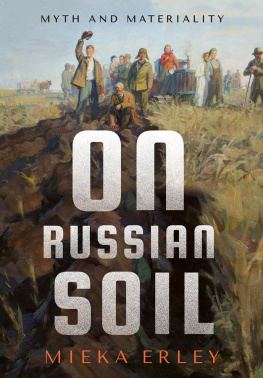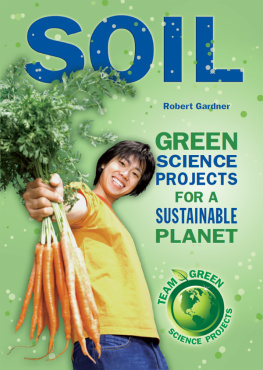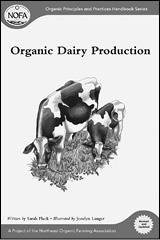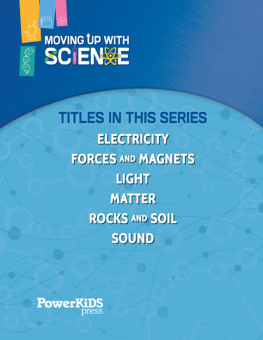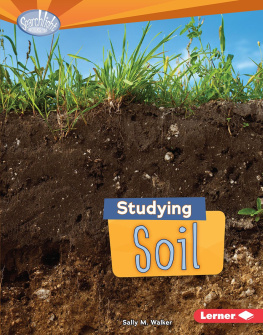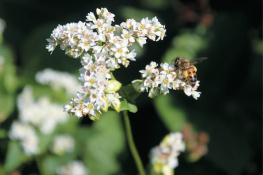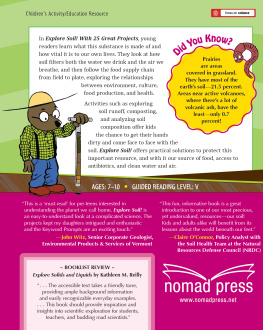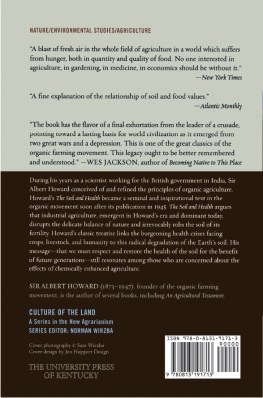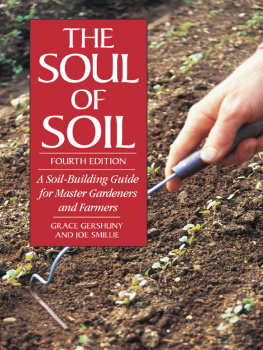
A volume in the NIU Series in Slavic, East European, and Eurasian Studies
Edited by Christine D. Worobec
For a list of books in the series, visit our website at cornellpress.cornell.edu.
Copyright 2021 by Cornell University
All rights reserved. Except for brief quotations in a review, this book, or parts thereof, must not be reproduced in any form without permission in writing from the publisher. For information, address Cornell University Press, Sage House, 512 East State Street, Ithaca, New York 14850. Visit our website at cornellpress.cornell.edu.
First published 2021 by Cornell University Press
Library of Congress Cataloging-in-Publication Data
Names: Erley, Mieka, author.
Title: On Russian soil : myth and materiality / Mieka Erley.
Description: Ithaca [New York] : Cornell University Press, 2021. | Series: NIU series in Slavic, East European, and Eurasian studies | Includes bibliographical references and index.
Identifiers: LCCN 2020051001 (print) | LCCN 2020051002 (ebook) | ISBN 9781501755699 (hardcover) | ISBN 9781501755705 (epub) | ISBN 9781501755712 (pdf)
Subjects: LCSH: Human ecologyRussia. | SoilsPhilosophy. | Cultural landscapesRussia. | SoilsMythologyRussia.
Classification: LCC GF601 .E75 2021 (print) | LCC GF601 (ebook) | DDC 631.40947dc23
LC record available at https://lccn.loc.gov/2020051001
LC ebook record available at https://lccn.loc.gov/2020051002
Cover illustration: P. S. Danilov, Pervaia borozda , canvas and oil, 195758. A. Kasteyev Museum of Arts, Republic of Kazakhstan.
Preface
In a family photograph from the 1920s, my grandmother and her sister, toddlers with bobbed hair, are sitting in a field encircled by chickens on the farm their mother owned in the Bluegrass region of Kentucky. As children, they worked alongside their mother in this field, setting tobacco, planting strawberries, and picking beans for market through the years of the Great Depression. I have fond memories of childhood visits to the farm, where muddy cattle trails ran alongside the Little Elkhorn creek, and where a stunning variety of wildflowers grewSolomons seal, stonecrop, and the quaintly named butter-and-eggs plant, which I collected and pressed in a botanical album. But by the 1980s there was already a decisive consolidation of industrial farming in the United States. With encroaching development, the decline of tobacco, and the rise of big agribusiness, few small family farms in Kentucky like my grandmothers were sustainable by the close of the Reagan era. In 1996, after the passing of my great-grandmother, aged 101, on the farm she had lived on her entire life, most of that farmland was sold for suburban tract houses. In our private life it was the end of four generations of farmers on that Bluegrass land, and in America it was the definitive end of the great georgic myth of America as an agrarian republic of smallholders.
In America as in Russia, many of us are only a few generations away from working the land and the constant attention to seasonal cycles, weather, fertilizer, and above all, the condition of the soil. The Green Revolution that enabled this demographic shift over the course of the twentieth century did not solve what nineteenth-century Russians called the soil question but rather rendered it invisible in many parts of the industrialized world. But the soil question has returned to visibility in recent years, from the growth of community-supported agriculture and the revival of small organic farms to internet discussions about the lack of micronutrients in industrially farmed food. As Wendell Berry writes, The soil is the great connector of lives, the source and destination of all. Without proper care for it we can have no community, because without proper care for it we can have no life.
This book is a historical study of a distinctive place and time, but it is motivated by a broader desire to understand how people make sense of the hard material realities of the human conditionin this case our dependency on the soil to feed ourselvesand how these material realities shape our dreams and myths. Agriculture has been our security against the state of bare life, but climate change has made us more aware of the fragility of our existence, our dependence on nature, and the limits of our ability to solve any problem with technology, and we are again urgently revisiting questions about how we use our limited arable land.
Soil remains an ongoing source of material resistance in a world of frictionless data, where the immaterial dialectic of binary code seems to master all material flows. However virtual life may appear, grain is still grain, in the words of Leonid Brezhnev, and soil is still soil. One day we may indeed loosen our immemorial ties to the soil as technological innovations offer new means of food production, but for now our dependency on the soil is a universal condition that unites human societies across millennia. The story of Russias relationship to its soil may serve to remind us of the conditions of food scarcity that were once a central feature of human experienceconditions that still persist in the developing world and that, in the age of planetary climate change, may once again come to define our lives.
Acknowledgments
No book is produced by the author alone. I am indebted to everyone who supported this project or shared their time, energy, and ideas. Sam Hodgkin more than anyone else enabled this project to materialize and shared the burdens that it entailed over many years. My sincere thanks also go to my colleagues in the Russian and Eurasian Studies Program at Colgate University: Sergei Domashenko, Jessica Graybill, Carolyn Guile, Ian Helfant, Alexander Nakhimovsky, Alice Nakhimovsky, Nancy Ries, and Kira Stevens. I am especially grateful to Alice Nakhimovsky for staying on message about what it takes to finish a book.
Language is the foundation of this project, and I thank those who taught me Russian language and literature at Hampshire College and Amherst College, especially Joanna Hubbs, Stanley Rabinowitz, Viktoria Schweitzer, Catherine Ciepiela, Tatyana Babyonysheva, and Jane Taubman. In the Department of Slavic Languages and Literatures at the University of California, Berkeley, Lisa Little and Anna Muza supported my development as a teacher and ongoing student of Russian. It was a privilege to have such readers as Irina Paperno, Olga Matich, Eric Naiman, Harsha Ram, Anne Nesbet, and Viktor Zhivov, and I am further indebted to Joachim Klein for sharing his expertise on topics as varied as pastoral poetry and the history of the Belomor Canal. I owe Irina Paperno and Olga Matich a special debt of gratitude for their generous support and care. They have fundamentally and indelibly shaped how I think.
Thanks go to all the editors and staff at NIU Press and Cornell Press, including Christine D. Worobec, Jennifer Savran Kelly, and especially Amy Farranto for her support through the life changes that occurred between the contract and final manuscript. I am grateful to Andy Bruno and Thomas Newlin, who reviewed this manuscript for NIU Press and who took time, in the midst of a pandemic, to generously share their ideas and discuss specific problems. Any shortcomings in this text are my own, of course.
A formative influence on this book was the Eurasian Environments conference in 2011 at Ohio State University, organized by Nicholas Breyfogle. This was my first encounter with environmental history, and my thanks go to the participants of that conference for having shared their work and welcomed a Slavist into their midst, with special thanks to Nicholas Breyfogle, Maya Peterson, Andy Bruno, Pey-Yi Chu, and Julia Obertreis. I am also grateful to Mark Bassin, Jane Costlow, Irina Sandomirskaia, and Jillian Porter for sharing ideas or reading parts of this material at various stages.
Next page
